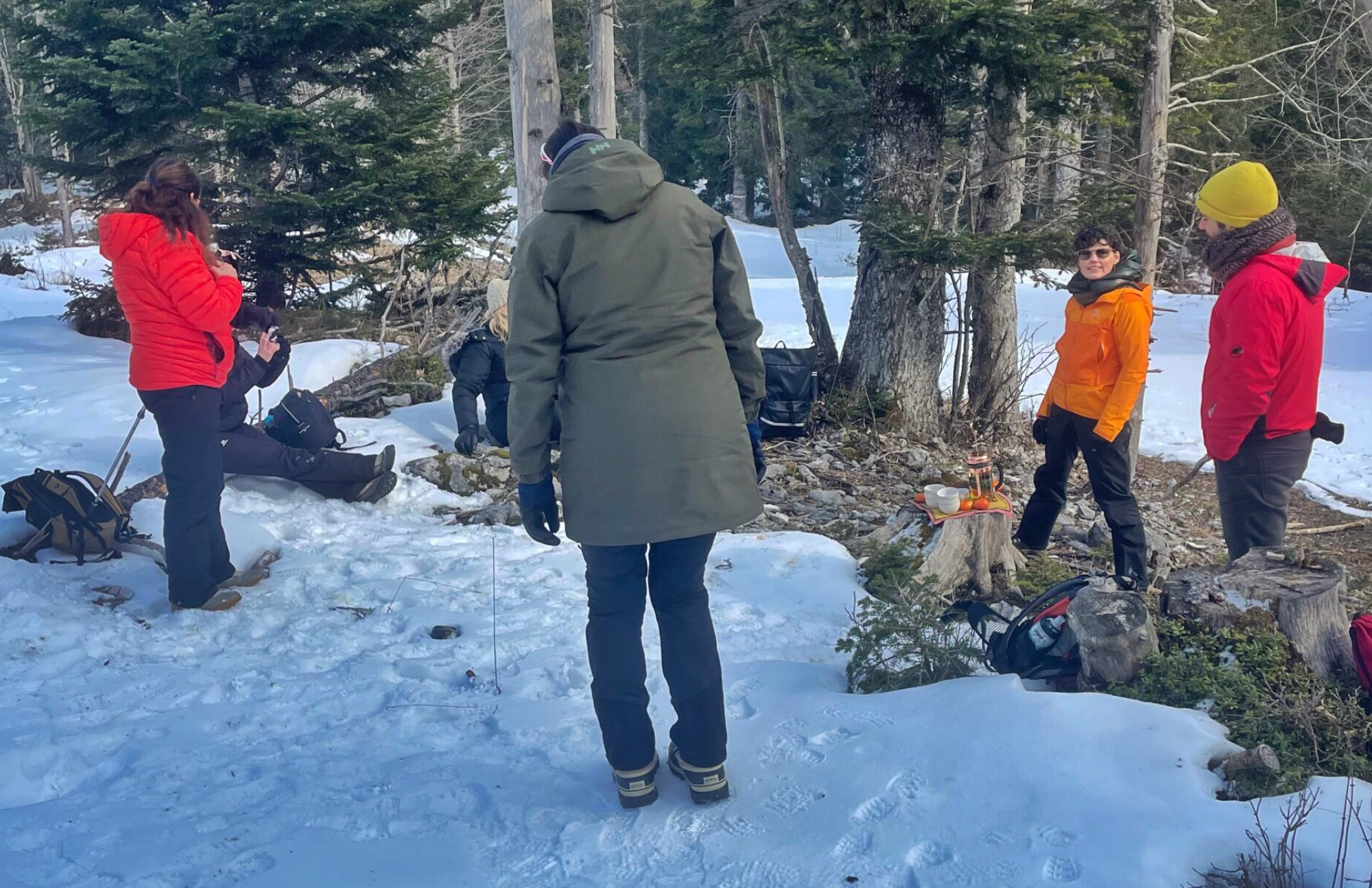Forest Bathing
Forest bathing, also known as “shinrin-yoku”, is a practice that originated in Japan in the 1980s. It was developed as a response to the stress and anxiety of modern city life, and was inspired by traditional Japanese practices of immersing oneself in nature for health and well-being.
The term “shinrin-yoku" was coined by the Japanese government in 1982 to promote the health benefits of spending time in nature. The government launched a series of studies to explore the effects of forest bathing on human health. They found that spending time in forests could reduce stress, lower blood pressure, and improve immune function.
During forest bathing, participants are encouraged to use their senses to connect with their natural surroundings. This involves taking deep breaths of the fresh forest air, listening to the sounds of the forest, feeling the texture of the trees and the forest floor, and even tasting some of the edible plants. It's not about exercise or trying to reach a specific destination. It's rather about immersing oneself in the natural environment and allowing it to have a calming and rejuvenating effect on the mind and body.

My Recent Forest Bath
Last week I experienced my first formal forest bath. I was guided through a wooded area in my local area of Annecy, France for a two and a half hour forest therapy experience lead by a knowledgeable and certified guide, Amy Charnay. Having previously spent time “mindfully in nature” I thought this would be a similar experience, perhaps with more structure and the added energy of being in a group. While mindfully going into the forest and getting closer to nature is also enjoyable, being guided through a therapeutic bath in the forest was more profound than I could have imagined.
Forest bathing reflections:
Walking through the forest I felt the presence of the trees. They waved at me and recognized my presence.
Feeling, touching, and tasting nature, I welcomed the energy of the other life around me. I went deep inside. Concentrating on being present and allowing the forest to communicate with me, I embarked on a journey of joy, beauty and discovery.
When asked to stand firmly and be present, my feet grew roots into the ground and my head reached high to the sun. When invited to breathe in, drink in and taste the forest around me, I sucked in the cold winter air using my mouth as a straw. I felt the small snowflakes land and melt on my cheeks. I was focused fully on where I stood.
Walking and watching the forest in motion, I saw the trees in ways I hadn’t before. Exploring water in all its forms, my experience took me deep into the life force that water is. Made mainly of this element, we humans are malleable like water and our energy and force move and change with our energy - positive and negative.
For two hours I focused on where I was, what I was seeing, and what I was experiencing. How it looked, how it tasted, how it felt, and how it sounded were how I engaged with this beautiful wood. I then had the opportunity to share what I was noticing and experiencing with those around me, deepening the experience as we brought each other into our own little worlds of observation.
With total presence of mind and gratitude, I bathed deeply in in the Parc Naturel Regional du Massif des Bauges, and vowed I would be back.

Here are five key methods that are commonly used in forest bathing:
Mindfulness: Forest bathing involves being fully present in the moment and taking in the sights, sounds, and smells of the natural environment. This can help to calm the mind and reduce stress.
Deep Breathing: Deep breathing exercises can help to relax the body and reduce tension. In forest bathing, practitioners often engage in deep breathing exercises while surrounded by the natural environment.
Walking: Walking is a key aspect of forest bathing, and practitioners often walk slowly and deliberately to fully immerse themselves in the natural environment. This can help to improve circulation, reduce stress, and promote relaxation.
Sensory Awareness: Forest bathing involves using all of the senses to fully experience the natural environment. This can include listening to the sounds of the forest, feeling the texture of the trees, and smelling the fragrance of the plants.
Mindful Observation: In forest bathing, practitioners often engage in mindful observation, taking the time to notice and appreciate the natural beauty of their surroundings. This can help to foster a deeper connection with nature and promote a sense of awe and wonder.
The practice of "letting go.": This involves letting go of distractions, worries, and negative thoughts, and instead focusing on the present moment and the natural environment. Letting go can be achieved through various techniques, such as visualization, meditation, or simply focusing on the breath while surrounded by nature. By practicing letting go, forest bathers can fully immerse themselves in the healing power of the forest and reap the many benefits of this practice.

How Does Forest Bathing Help You Live Better?
Studies have shown (a variety are listed below) that forest bathing can have many health benefits. These include reducing stress and anxiety, boosting the immune system, improving mood, and promoting better sleep.
Here are just a few ways that forest bathing has been shown to help you live a better life:
Reducing stress: Spending time in nature has been shown to reduce stress levels and improve overall well-being. Forest bathing can help you to relax and reduce anxiety, which can improve your mental and physical health.
Boosting immunity: Studies have found that forest bathing can boost the immune system, potentially helping to prevent illness and disease.
Improving mood: Being in nature can help to improve your mood and increase feelings of happiness and well-being. Forest bathing can help to reduce symptoms of depression and anxiety.
Increasing creativity: Spending time in nature can help to stimulate creativity and boost cognitive function. Forest bathing can help you to think more creatively and come up with new ideas.
Enhancing physical fitness: Forest bathing is a gentle form of exercise that can improve your physical fitness. Walking or hiking through nature can help to increase your cardiovascular health and reduce the risk of chronic disease.

The scientific evidence of forest bathing health benefits
Leading Books on Forest Bathing
There are several books on forest bathing that provide a detailed understanding of the practice and its benefits.
Here are some of the leading books on forest bathing:
- "Shinrin-Yoku: The Japanese Art of Forest Bathing" by Yoshifumi Miyazaki. This book provides an in-depth exploration of the origins and practice of forest bathing as well as the benefits for health and well-being. It includes practical guidance on how to incorporate forest bathing into your daily life.
- "The Nature Fix: Why Nature Makes Us Happier, Healthier, and More Creative" by Florence Williams. This book explores the science behind the health benefits of spending time in nature. It includes stories from people who have experienced the benefits of nature immersion, as well as practical tips on how to incorporate nature into your life.
- "Forest Bathing: How Trees Can Help You Find Health and Happiness" by Dr. Qing Li. This book is written by one of the world's leading experts on forest medicine and provides a comprehensive overview of the health benefits of forest bathing. It includes practical guidance on how to practice forest bathing and incorporate it into your daily routine.
- "The Healing Magic of Forest Bathing: Finding Calm, Creativity, and Connection in the Natural World" by Julia Plevin. This book provides a beginner's guide to forest bathing and explores the practice's potential to reduce stress, boost creativity, and improve overall well-being. It includes exercises and techniques to help you get the most out of your forest bathing experience.
Top forest bathing scholars:
- Dr. Qing Li: Dr. Qing Li is a professor at Nippon Medical School in Tokyo, Japan, and is considered one of the world's leading experts on forest medicine. He has conducted extensive research on the health benefits of forest bathing. These include the effects on immune function, stress reduction, and cardiovascular health.
- Dr. Yoshifumi Miyazaki: Dr. Yoshifumi Miyazaki is a professor at the Chiba University Graduate School of Horticulture in Japan, and is a leading expert in the field of forest therapy. He has conducted research on the physiological effects of forest bathing. These include changes in heart rate, blood pressure, and cortisol levels.
- Dr. Bum Jin Park: Dr. Bum Jin Park is a professor at the Korea University College of Medicine in Seoul, South Korea. He has conducted research on the effects of forest bathing on cardiovascular health. These include blood pressure and heart rate variability.
- Dr. Marc Berman: Dr. Marc Berman is an assistant professor of psychology at the University of Chicago in the United States. He has conducted research on the cognitive benefits of nature exposure. These include improvements in attention and memory.
- Dr. Terry Hartig: Dr. Terry Hartig is a professor of environmental psychology at Uppsala University in Sweden. He has conducted research on the effects of nature exposure on stress reduction, cognitive function, and overall well-being.

Leading Studies on Forest Bathing:
"Forest bathing enhances human natural killer activity and expression of anti-cancer proteins" by Qing Li et al. (2010). This study found that spending time in a forest environment increased natural killer cell activity and boosted the immune system's ability to fight off cancer.
"Psychological effects of forest environments on healthy adults: Shinrin-yoku (forest-air bathing, walking) as a possible method of stress reduction" by Yoshifumi Miyazaki et al. (2011). This study found that forest bathing reduced stress and improved overall well-being in healthy adults.
"Physiological and psychological effects of forest therapy on middle-aged males with high-normal blood pressure" by Bum Jin Park et al. (2010). This study found that forest therapy, including forest bathing and walking, reduced blood pressure and improved overall cardiovascular health in middle-aged men with high-normal blood pressure.
"The cognitive benefits of interacting with nature" by Marc G. Berman et al. (2008). This study found that exposure to natural environments improved cognitive function, including attention and memory.
"Restorative effects of viewing real forest landscapes, based on a comparison with urban landscapes" by Takayuki Tsunetsugu et al. (2007). This study found that viewing forest landscapes reduced stress and improved mood more than urban landscapes.
Have you tried forest bathing?
Forest bathing is not only enjoyable but offers us immense benefits for healthier living. If you don’t already, try to spend at least 10 minutes a day in a green space. Be present in your approach. Listen deeply, smell, feel and observe. Try and use this time to be only where you are and nowhere else. Enjoy being soaked in the forest’s beauty.

